All the test pieces except one shows yellow sparks. This could mean they're either steel of some kind or charcoal iron.
I compared with known modern mild steel and it showed a light yellow spark, clearly lighter colored than the one I got from the possible iron. I also tested a spring steel piece ( the last test piece), part of an old tractor spring, and it sparked dark red.
I also did bend to breaking tests with all the pieces except the large band which alread was broken off that way and was showing segmentation typical of wrought iron. Most bend offs were inconclusive, could be either wrought iron with very fine grain (very high quality stuff) or some form of mild steel.
Next stage is to mirror polish surfaces and etch with acid, then view in a digital USB connected light microscope. I did some experimentation but didn't have a potent enough acid at hand, and the polishing which seemed flawless mirror turned out to be rougher than needed when viewed in the microscope. What could be seen seems to be ferritic structure, which would indicate wrought iron, but so far it's inconclusive.
What I can determine so far is that one test piece is spring steel, and the rest show the telltale non-red spark that would make them either some form of mild steel or Charcoal Iron. None of it is puddle iron, though I have lots of other untested pieces that might be.
| Dan Howard wrote: |
| There have been a few studies that have shown that there is no difference in the rate of deterioration between wrought iron and steel. The exception is the presence of slag stringers which can apparently act as a conduit to take contaminants deeper into the material. If anything puddled iron should deteriorate faster than modern steel. |
Hi Dan, Sorry to jump topic here but could you please share some of these studies with me, or point me in the right direction. I flat out don't buy it. Aren't those "slag" stringers made of what is essentially glass? If I'm about to change what I tell people about the weathering properties of wrought iron I'd like to be able to back it up properly.
Thanks, Jeff
I too would be most interested in source material on that, as it goes against what is commonly said in both iron blacksmith circles as well as all expert high level metallygy research I've been able to dig up on the subject.
That's not to say it's false, new research often disproves it's predecessors to some degree as a science progresses, just that we need a little bit more source material to go on in this case.
That's not to say it's false, new research often disproves it's predecessors to some degree as a science progresses, just that we need a little bit more source material to go on in this case.
Wow, I made some butted 4mm years ago. A sq ft took me 60 hrs.
You, Sir, have the patience of Job.
You, Sir, have the patience of Job.
Well, I would have if I was making this 24/7 and aiming realistically at making a full haubergon, but I'm not. At least not for now. This is just craft method revival so far.
I've added considerably to the weave of the maille since I posted photos last though, but it's still just a small patch.
But for sure the original maille maker, or makers of the Gjermundbu maille would have had a lot of patience and skill.
I've added considerably to the weave of the maille since I posted photos last though, but it's still just a small patch.
But for sure the original maille maker, or makers of the Gjermundbu maille would have had a lot of patience and skill.
More recent news about the project!
I've mentioned Vegard Vike and his work early on in the thread as it's the major source and inspiration for it. Well, my maille making friend and mentor Niclas ran into Vegard at Wisby medieval week in the re-enactment camp last week and had some very interesting discussions on the subject. He was discussing watershed effects with Niclas, among other things and it turns out it can be more things or the term can be applied in more ways to maille than one first thinks.
Me and Niclas were trying to get hold of him again so I could meet him too, but we never managed. Possibly he went home early from the event or had other duties elsewhere on the island. And my friend had other things to take care of too, like being filmed by TV and Historiska museet demonstrating maille making. As far as I gathered this is going up on their museum info site. Very exciting to be sure. ;)
But Niclas got Mr Vikes contact info and is going to help me get in contact with him too. As he's studied the Gjermnudbu maille scientifically in great detail and most likely knows more about it than anyone else alive today, I'm hoping to get some feedback and pointers on how to make my method of production even better and more authentic.
One new detail Niclas got from Vegard was that the rivet dome has a double bulb, one on top of the other. You can clearly see it in the photo on the excellent (but short overview) Hurstwic site.
On the middle of this webpage: http://www.hurstwic.org/history/articles/manu...g_mail.htm
Or here:
[ Linked Image ]
Incidentally I found several of my own riveted links have the same shape. I've been trying to work that off them, but clearly I shouldn't. In fact when I make my next riveting plier set I'll make two, one with a large dome for first stage crimping and another second one with a smaller recess for second stage to shape the top bulb.
I've mentioned Vegard Vike and his work early on in the thread as it's the major source and inspiration for it. Well, my maille making friend and mentor Niclas ran into Vegard at Wisby medieval week in the re-enactment camp last week and had some very interesting discussions on the subject. He was discussing watershed effects with Niclas, among other things and it turns out it can be more things or the term can be applied in more ways to maille than one first thinks.
Me and Niclas were trying to get hold of him again so I could meet him too, but we never managed. Possibly he went home early from the event or had other duties elsewhere on the island. And my friend had other things to take care of too, like being filmed by TV and Historiska museet demonstrating maille making. As far as I gathered this is going up on their museum info site. Very exciting to be sure. ;)
But Niclas got Mr Vikes contact info and is going to help me get in contact with him too. As he's studied the Gjermnudbu maille scientifically in great detail and most likely knows more about it than anyone else alive today, I'm hoping to get some feedback and pointers on how to make my method of production even better and more authentic.
One new detail Niclas got from Vegard was that the rivet dome has a double bulb, one on top of the other. You can clearly see it in the photo on the excellent (but short overview) Hurstwic site.
On the middle of this webpage: http://www.hurstwic.org/history/articles/manu...g_mail.htm
Or here:
[ Linked Image ]
Incidentally I found several of my own riveted links have the same shape. I've been trying to work that off them, but clearly I shouldn't. In fact when I make my next riveting plier set I'll make two, one with a large dome for first stage crimping and another second one with a smaller recess for second stage to shape the top bulb.
Brilliant. Looking forward to seeing the finished work.
| J Helmes wrote: | ||
Hi Dan, Sorry to jump topic here but could you please share some of these studies with me, or point me in the right direction. I flat out don't buy it. Aren't those "slag" stringers made of what is essentially glass? If I'm about to change what I tell people about the weathering properties of wrought iron I'd like to be able to back it up properly. Thanks, Jeff |
There was a large discussion on the arch-metals mailing list few years ago
ARCH-METALS@JISCMAIL.AC.UK
They presented more than enough evidence to convince me but I'm not a metallurgist.
| Johan Gemvik wrote: |
|
One new detail Niclas got from Vegard was that the rivet dome has a double bulb, one on top of the other. You can clearly see it in the photo on the excellent (but short overview) Hurstwic site. On the middle of this webpage: http://www.hurstwic.org/history/articles/manu...g_mail.htm Or here: [ Linked Image ] Incidentally I found several of my own riveted links have the same shape. I've been trying to work that off them, but clearly I shouldn't. In fact when I make my next riveting plier set I'll make two, one with a large dome for first stage crimping and another second one with a smaller recess for second stage to shape the top bulb. |
I don't get it - what is so special about the double bulb? I believe it happens when the dome created by piercing the ring differs from the depression in the rivet setting pliers. I also get this effect constantly when I use my older pliers that have some wear in them.
You have done good work developing the punched ring prosess for the gjermundbu mail Johan. Interesting to see the presentation here. There is one detail of the process that I was not aware of when i wrote my little paper "Brynjevev/Ring weave". I discovered it during later studies. I will share it with you here shortly so that you have the opportunety to perfect the prosess.
I agree with you Andris, there may have been a misunderstanding. The double dome is not the result of setting the rivet twice with two different sized peening depressions. It is the result of the hole for punching/drifting beeing slightly larger in diameter than the depression for the peening of the rivet. The rivets used for the gjermundbu mail is almost round in cross section (and somewhat conical in shape). The hole for punching/drifting has therefore also been round.
There are also other interesting toolmarks on the rings. They are not present on all the rings (that includes the double dome), and are not equally common, but they can be found frequently on the best preserved riveted rings from the gjermundbu grave find. (By the way. Notice the backside of the rivet area. The rivet is flush with the ring material, and there is no visible transition between the metal of the ring and the rivet. This quality is quite common on period mail as I can remember, but few are able to reproduce this today, so we are doing something wrong).
[ Linked Image ]
[ Linked Image ]
 Attachment: 133.38 KB
Attachment: 133.38 KB
Toolmarks on riveted mail rings from the gjermundbu mail [ Download ]
 Attachment: 207.55 KB
Attachment: 207.55 KB
Riveted rings, gjermundbu mail [ Download ]
| Andris Auzins wrote: | ||
I don't get it - what is so special about the double bulb? I believe it happens when the dome created by piercing the ring differs from the depression in the rivet setting pliers. I also get this effect constantly when I use my older pliers that have some wear in them. |
I agree with you Andris, there may have been a misunderstanding. The double dome is not the result of setting the rivet twice with two different sized peening depressions. It is the result of the hole for punching/drifting beeing slightly larger in diameter than the depression for the peening of the rivet. The rivets used for the gjermundbu mail is almost round in cross section (and somewhat conical in shape). The hole for punching/drifting has therefore also been round.
There are also other interesting toolmarks on the rings. They are not present on all the rings (that includes the double dome), and are not equally common, but they can be found frequently on the best preserved riveted rings from the gjermundbu grave find. (By the way. Notice the backside of the rivet area. The rivet is flush with the ring material, and there is no visible transition between the metal of the ring and the rivet. This quality is quite common on period mail as I can remember, but few are able to reproduce this today, so we are doing something wrong).
[ Linked Image ]
[ Linked Image ]
Toolmarks on riveted mail rings from the gjermundbu mail [ Download ]
Riveted rings, gjermundbu mail [ Download ]
Last edited by Vegard Vike on Sun 28 Aug, 2011 4:46 pm; edited 3 times in total
Here is a picture of a riveted ring from gjermundbu that I made a section of, then a closeup of the rivet on the same ring. The third picture is a tangential section of the rivet area of another ring. As mentioned before the rivets are slightly conical in shape, almost round in cross section.
 Attachment: 128.64 KB
Attachment: 128.64 KB

Section of riveted ring, gjermundbu mail
 Attachment: 95.32 KB
Attachment: 95.32 KB
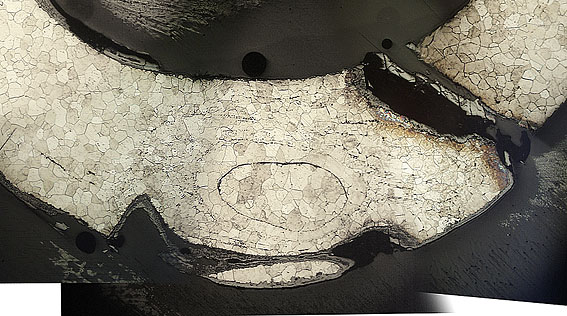
Closeup of rivet area, plane section of riveted ring, gjermundbu mail
 Attachment: 75.09 KB
Attachment: 75.09 KB
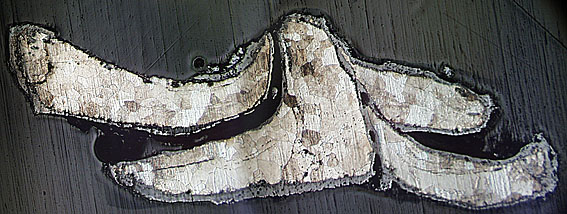
Tangential section of riveted ring, gjermundbu mail

Section of riveted ring, gjermundbu mail

Closeup of rivet area, plane section of riveted ring, gjermundbu mail

Tangential section of riveted ring, gjermundbu mail
Oh that is wonderful Vegard, many thanks for sharing.
Then on to the punched rings. The rounding of the edges on mail rings after the punching generally may have been done by grinding them down as you have described doing Johan. Arne Jouttijärvi, myself and probably others have come to that conclusion, and have refered to the illustration of the ringmaker from the year 1425 in Das Hausbuch der Mendelschen Zwölfbrüderstiftung zu Nürnberg. The ringmaker seems to be a general ringmaker, and not spesifically a mail ringmaker, so it is open to discussion though.
After writing my paper on the metallografic studie of three mail finds, I took a closer look at the gjermundbu mail, and found out that the rings had not been grinded, but where instead rehaped after the punching by a sort of dropforging. What gave it away was some faulty rings, especially one in particular, that had been put a squew into the shaping/dropforging tool. I think I have to give you an illustration of this, and in addition som pictures of the faulty ring, hopefully it will explain it.
[ Linked Image ]
 Attachment: 61.91 KB
Attachment: 61.91 KB
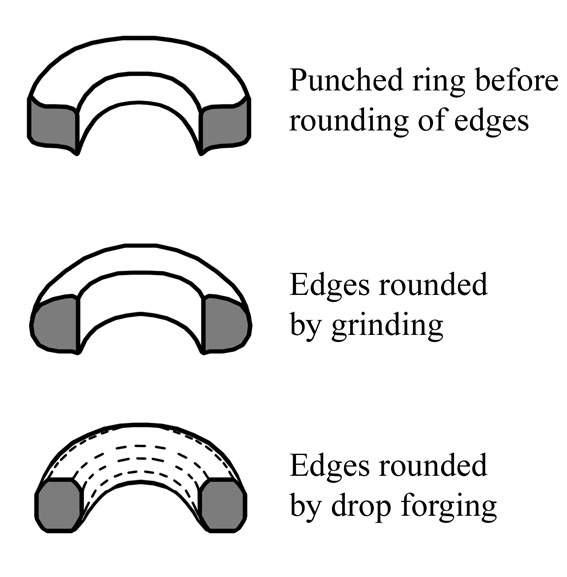
Rounding of edges on a punched ring
 Attachment: 66.02 KB
Attachment: 66.02 KB
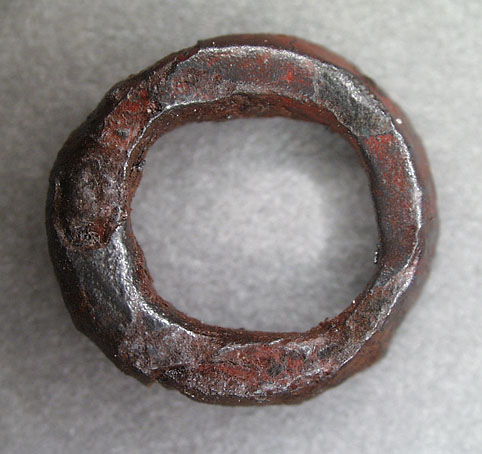
Punched ring of standard form, note the rounded shape of the edges both on the inside and outside.
 Attachment: 84.5 KB
Attachment: 84.5 KB
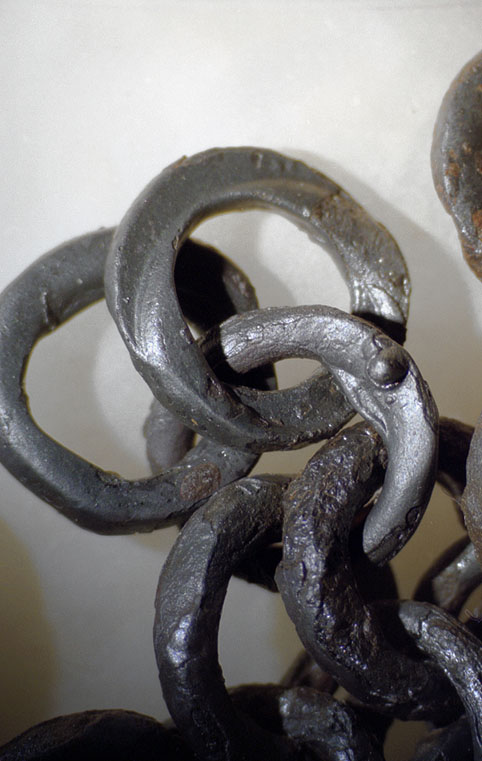
The faulty ring
 Attachment: 52.53 KB
Attachment: 52.53 KB
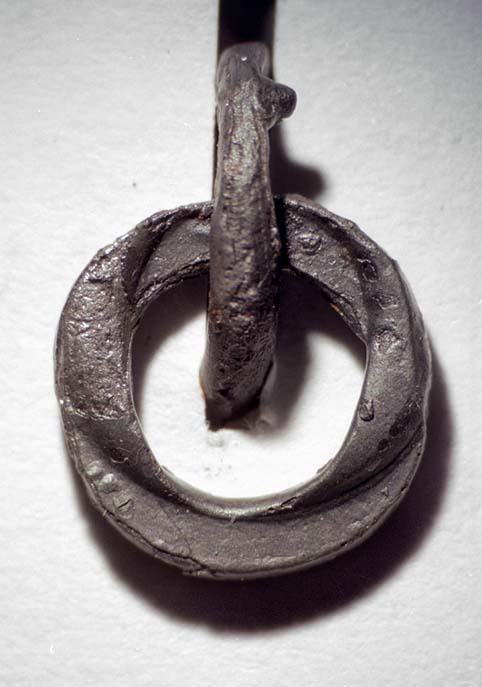
The faulty ring. Closeup.
 Attachment: 176.1 KB
Attachment: 176.1 KB
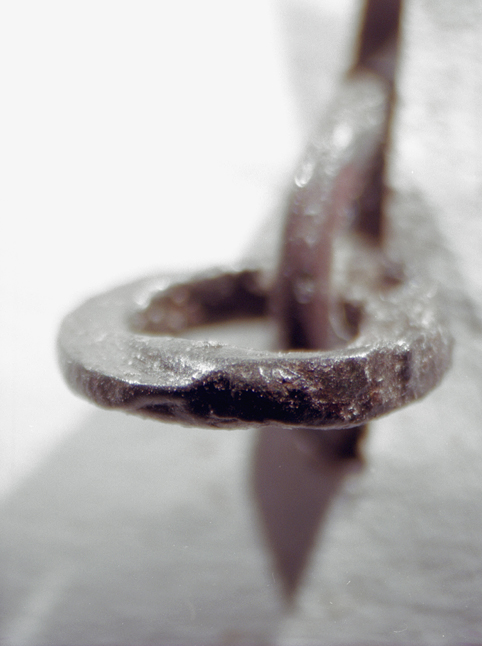
The faulty ring, seen from the edge.
 Attachment: 81.3 KB
Attachment: 81.3 KB
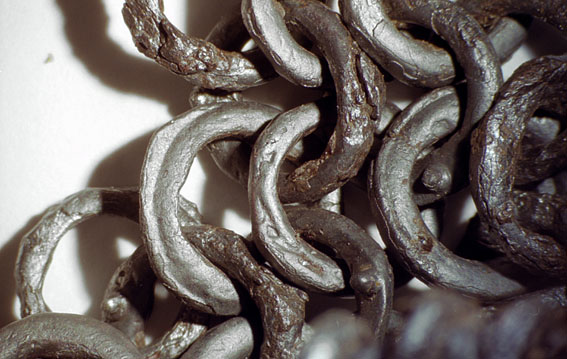
More faulty rings.
 Attachment: 73.09 KB
Attachment: 73.09 KB
Punching and reshaping/dropforging [ Download ]
After writing my paper on the metallografic studie of three mail finds, I took a closer look at the gjermundbu mail, and found out that the rings had not been grinded, but where instead rehaped after the punching by a sort of dropforging. What gave it away was some faulty rings, especially one in particular, that had been put a squew into the shaping/dropforging tool. I think I have to give you an illustration of this, and in addition som pictures of the faulty ring, hopefully it will explain it.
[ Linked Image ]

Rounding of edges on a punched ring

Punched ring of standard form, note the rounded shape of the edges both on the inside and outside.

The faulty ring

The faulty ring. Closeup.

The faulty ring, seen from the edge.

More faulty rings.
Punching and reshaping/dropforging [ Download ]
Last edited by Vegard Vike on Tue 30 Aug, 2011 4:18 pm; edited 2 times in total
The roman mail from Hedegård in Denmark var studied and described to reproduce its construction by Michel Kalsbøll Malfilâtre in 1993. From that publication these illustrations show the shaping of punched rings. This method is similar to the one used on the gjermundbu rings, but not exactly the same. The tool illustrated for the shaping of the Hedegård rings could not have produced the faulty ring from the gjermundbu mail.
[ Linked Image ]
 Attachment: 120.69 KB
Attachment: 120.69 KB
Hedegård mail. Shaping of punched rings. By Michel Kalsbøll Malfilâtre 1993 [ Download ]
[ Linked Image ]
Hedegård mail. Shaping of punched rings. By Michel Kalsbøll Malfilâtre 1993 [ Download ]
please tell me maile makers had a couple of servents...
but even if he did i can understand more fully why maile was considered such a hard to get and therefore expensive item during the dark age/ viking age/ medieval period. and why the romans made their legionaries use segmentata mostly
but if i may make a suggestion, this might be something already thought of, and i realise this is experimental work, but im wondering how possible it would be to have multiples of the solid ring puncher etc.
and one other question, are the non solid links attatched to the weave before or after they have the overlapped ends flattened? (in order to be pierced and then riveted)
but even if he did i can understand more fully why maile was considered such a hard to get and therefore expensive item during the dark age/ viking age/ medieval period. and why the romans made their legionaries use segmentata mostly
but if i may make a suggestion, this might be something already thought of, and i realise this is experimental work, but im wondering how possible it would be to have multiples of the solid ring puncher etc.
and one other question, are the non solid links attatched to the weave before or after they have the overlapped ends flattened? (in order to be pierced and then riveted)
| William P wrote: |
| please tell me maile makers had a couple of servents...
but even if he did i can understand more fully why maile was considered such a hard to get and therefore expensive item during the dark age/ viking age/ medieval period. and why the romans made their legionaries use segmentata mostly but if i may make a suggestion, this might be something already thought of, and i realise this is experimental work, but im wondering how possible it would be to have multiples of the solid ring puncher etc. and one other question, are the non solid links attatched to the weave before or after they have the overlapped ends flattened? (in order to be pierced and then riveted) |
I can only comment from using pre overlapped / pierced rings.
Once you start the weaving of the maille to then try and flatten and pierce with a drift prior to riveting while in the weave would be nigh on impossible and extremely time consuming. When you start doing expansions where you end up with five rings connected to a single ring rather than the normal four it can get tricky enough to place and crimp the rivet as it is.
So I would suggest that for the timeliness and also accuracy all rings would be overlapped, flattened and pierced with a drift prior to adding to the weave :)
On topic, the content of this thread is amazing, not only from the OP but also the additional information. So very educating, thanks!
Brett
i guessd thats a good point,
and now that i think of it, the drifted hole would possibly help the ends line up properly when reclosing the link after adding it to the weave.
and now that i think of it, the drifted hole would possibly help the ends line up properly when reclosing the link after adding it to the weave.
Great to see you on the forum and thank you so much Vegard!
I'm so sorry we passed each other on Wisby as I've been a great fan of your maille research ever since I first read the Brynjevev paper many years ago. But now you found the thread here instead.
Your shared insights and deailed photos are invaluable for making the rings accurately. I simply can't thank you enough! :)
I'll construct tools for drop forging the solids as soon as I'm able and I'll make sure to make some few that are misaligned even. When one has that tool it should save even more time and effort on manufacturing.
Also, funny enough I did use conical rivets first, but switched to slightly flattened very pointy triangles. I can just switch back to my frist rivet type, they were actually easier to work with.
I'll also try to make a plier or similar tool that actually gives the #5 mark at the rivet overlap. I have a leatherworkers plier that I can easily adapt as it has a removable joint screw. Much easier to get at those inner surfaces that way and it's hand forged so it looks nice already. I'm also thinking the plier jaw surfaces may need to be flat bottom and slightly concave top to get the right look as seen in the photos.
[ Linked Image ]
I'll give it a try and see how that turns out.
Could the #4 mark be from the rivet pressing tool? I don't see it on all riveted rings just some and so I'm guessing it could be the second pressing that sometimes does it if it's a little misaligned and the edge of it touches the ring.
I'm so sorry we passed each other on Wisby as I've been a great fan of your maille research ever since I first read the Brynjevev paper many years ago. But now you found the thread here instead.
Your shared insights and deailed photos are invaluable for making the rings accurately. I simply can't thank you enough! :)
I'll construct tools for drop forging the solids as soon as I'm able and I'll make sure to make some few that are misaligned even. When one has that tool it should save even more time and effort on manufacturing.
Also, funny enough I did use conical rivets first, but switched to slightly flattened very pointy triangles. I can just switch back to my frist rivet type, they were actually easier to work with.
I'll also try to make a plier or similar tool that actually gives the #5 mark at the rivet overlap. I have a leatherworkers plier that I can easily adapt as it has a removable joint screw. Much easier to get at those inner surfaces that way and it's hand forged so it looks nice already. I'm also thinking the plier jaw surfaces may need to be flat bottom and slightly concave top to get the right look as seen in the photos.
[ Linked Image ]
I'll give it a try and see how that turns out.
Could the #4 mark be from the rivet pressing tool? I don't see it on all riveted rings just some and so I'm guessing it could be the second pressing that sometimes does it if it's a little misaligned and the edge of it touches the ring.
Hi
My friend just ordered a mail with alternating solid and riveted rings from india. The solid rings he had in his mail were awfully thin. I didnt measure, but i think they were thinner than 1mm...
So how thick is the material you are punching the solids out from, and how thick are the solids in the gjermundbu maille.
Also, could you please tell if other surviving examples of mail have the same thickness for rings or are they thinner/thicker?
Sorry if you already wrote about it somewheare in the topic but i have missed it. :)
My friend just ordered a mail with alternating solid and riveted rings from india. The solid rings he had in his mail were awfully thin. I didnt measure, but i think they were thinner than 1mm...
So how thick is the material you are punching the solids out from, and how thick are the solids in the gjermundbu maille.
Also, could you please tell if other surviving examples of mail have the same thickness for rings or are they thinner/thicker?
Sorry if you already wrote about it somewheare in the topic but i have missed it. :)
Hi Robert,
I've used 1,5 mm plate to punch from so far. Inner diameter 5 mm and outer 8, making the ring square section. Of course, I now find they also need to be drop forged to be complete.
I've used 1,5 mm plate to punch from so far. Inner diameter 5 mm and outer 8, making the ring square section. Of course, I now find they also need to be drop forged to be complete.
Page 4 of 7
You cannot post new topics in this forumYou cannot reply to topics in this forum
You cannot edit your posts in this forum
You cannot delete your posts in this forum
You cannot vote in polls in this forum
You cannot attach files in this forum
You can download files in this forum
All contents © Copyright 2003-2006 myArmoury.com — All rights reserved
Discussion forums powered by phpBB © The phpBB Group
Switch to the Full-featured Version of the forum
Discussion forums powered by phpBB © The phpBB Group
Switch to the Full-featured Version of the forum